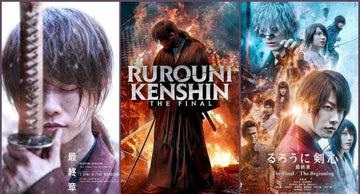From the manga pages associated with the childhood of the 8x-9x generation, Rurouni Kenshin has gone beyond the limits of a shonen comic series. And when adapted into a live-action series by director Keishi Ōtomo, this series not only retains the original spirit but also elevates it with powerful, sophisticated and profound cinematic language. Let's explore with Hobiverse now!
Review of Rurouni Kenshin movies
Rurouni Kenshin (2012) – The Beginning of a Legend
Kenshin, once the legendary assassin Hitokiri Battousai of the Bakumatsu period, now wields a reverse-bladed sword and atones for his sins by helping others. He accidentally meets Kaoru, the owner of the Kamiya dojo, and is drawn into the drug trafficking plot of the villain Kanryuu Takeda.

Highlights:
-
Building Kenshin's character with depth, both lovable and cold when necessary.
-
The action scenes are smooth, true to the original but still realistic, not "too anime".
-
Kaoru is a model of trust and gentleness, opening the way for a strong relationship to come.
A decent opening, not too complicated, opening up the nostalgic world of swordplay. The film focuses on introducing the characters and worldview, suitable for both manga fans and newcomers.
Rurouni Kenshin: Kyoto Inferno (2014) – When Evil Rises
Kenshin is summoned by the Meiji government to confront Makoto Shishio – his successor as assassin, but is betrayed and burned alive. Shishio survives, dreaming of overthrowing the government and burning the country. Kenshin is forced to break his oath of non-killing to save Japan.

Highlights:
-
Shishio is a powerful villain: intelligent, cruel, idealistic, but compelling.
-
The battles in the forest, on the train… are staged grandly and hauntingly.
-
Sub-lines like Saito, Misao, Aoshi... are very well developed, helping to expand the world of Kyoto.
This is a long, fast-paced, tense climax that marks Kenshin's physical and mental growth.
Rurouni Kenshin: The Legend Ends (2014) – End of the Battousai legend
After his defeat by Shishio, Kenshin seeks out his master Hiko Seijuro to learn his final technique – Amakakeru Ryu no Hirameki. He must overcome both his fear of killing and come to terms with his past if he is to win.

Highlights:
-
The teacher-student relationship is deep and emotional.
-
The final battle on the battleship with 4 vs 1 – Ken, Shishio and company – is one of the best action scenes in the samurai genre.
-
Kaoru and Kenshin have many deep, emotional moments filled with hidden meanings.
An extremely satisfying ending to the Shishio arc. The first half is slow, but the emotional and action build up later on.
Rurouni Kenshin: The Final (2021) – When the past won't let go
Yukishiro Enishi – the younger brother of his ex-wife Tomoe – appears with the goal of destroying everything Kenshin holds dear. Bringing the Shanghai Mafia with him, Enishi not only wants to kill Kenshin, but also force him to live in guilt and loneliness.

Highlights:
-
Deeply explores Kenshin's inner conflict: between redemption and past trauma.
-
Enishi is a pitiful villain, blinded by hatred – but still retains his charisma.
-
The return of old characters like Sanosuke, Yahiko, Kaoru… brings a sense of reunion to the film.
A new tragedy unfolds in Kenshin's life and is a strong emotional part. It pushes the Kenshin-Tomoe relationship to a climax, setting the stage for the sequel.
Rurouni Kenshin: The Beginning (2021) – Where all tragedies begin
This prequel reveals Kenshin's past before he wielded the reverse-bladed sword. He was once the cold-blooded, emotionless Battousai – until he met Tomoe Yukishiro, a girl who changed his life.

Highlights:
-
The film has a dark, picturesque tone and a tragic tone.
-
The relationship between Kenshin and Tomoe is portrayed gently, yet hauntingly.
-
Less action scenes but with depth and internal struggle.
This is the most cinematic part, a sad love song about redemption, love and the price of war.
Suggested viewing order according to story line:
-
The Beginning (assassin past)
-
Rurouni Kenshin (2012) (New Beginnings)
-
Kyoto Inferno
-
The Legend Ends
-
The Final (facing the past, ending the journey)
Kenshin's Journey of Atonement – The Most Beautiful Repentance with a Reverse-Edged Sword
Throughout the series, Kenshin Himura has been not only a character but also a symbol of redemption, forgiveness, and the redemptive power of humanity.
From a cold-blooded assassin with a bloody sword, Kenshin gradually became a protector of the weak, a man willing to sacrifice for the ideal of “a peaceful Japan”. But what haunts viewers the most is not the battles, but:
-
A sincere bow of apology
-
A regretful look when remembering Tomoe
-
And those silent moments with Kaoru, where Kenshin found the last bit of peace in his life.
The live-action Rurouni Kenshin film is an excellent retelling of a famous manga. It tells a story about humanity in wartime, about how the past shapes people but does not determine the future.
Outstanding strengths of the live-action version
Compared to anime/manga: What's better about live-action movies?
-
Faithful to the spirit of the original, especially in retaining Kenshin's ideals and major story milestones.
-
Outstanding in terms of emotion and acting: Kenshin's eyes in the movie can convey more than the manga pages.
-
Other characters (like Enishi, Shishio…) are toned down and deepened to fit the cinematic atmosphere.

The ultimate Japanese swordplay action movie
Unlike many CGI adaptations, Rurouni Kenshin dazzles with its realistic action scenes, with incredible speed, precision, and smooth staging. Satoh Takeru, who plays Kenshin, performed most of the action himself, making each blow, each turn feel weighty, realistic, and poetic.
Deep character psychology – not just fighting
The film is not simply a story of heroes fighting villains. Kenshin is a multi-layered character – both strong and fragile, always torn between ideals and sins. Characters like Tomoe, Kaoru, Enishi… are all impressive and are pieces in this journey of redemption. No one is completely good or bad, just people carrying trauma, searching for justice in an unstable world.
This is one of the best live-action adaptations. It is rare to find a manga adaptation that is so well-invested in terms of script, direction, acting, and philosophical depth.
Rurouni Kenshin is not just a wuxia film, but a beautiful repentance with a reverse-bladed sword, a question about how people can atone, live on, and love after experiencing the greatest darkness. A person who once killed people can still become a person who saves people. As long as the heart still believes in salvation.
Have you watched all the Rurouni Kenshin movies? Watch them in the order recommended by Hobiverse and experience the full emotion of the series.











